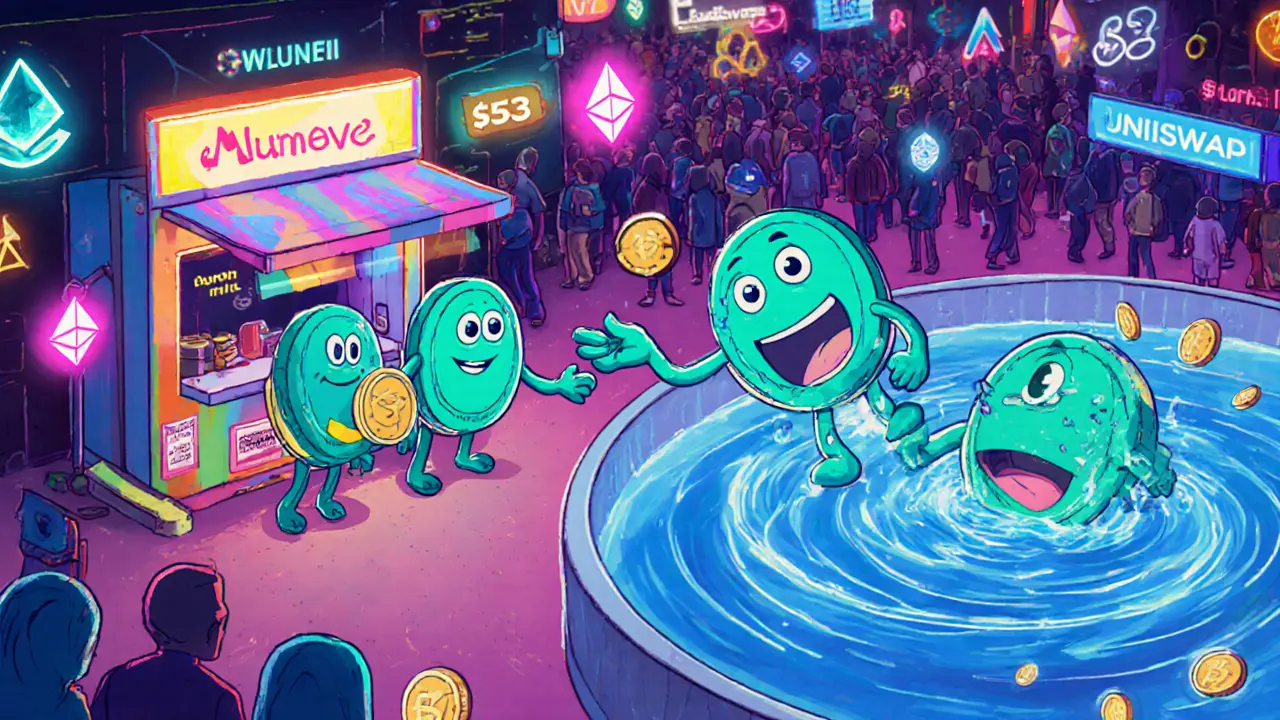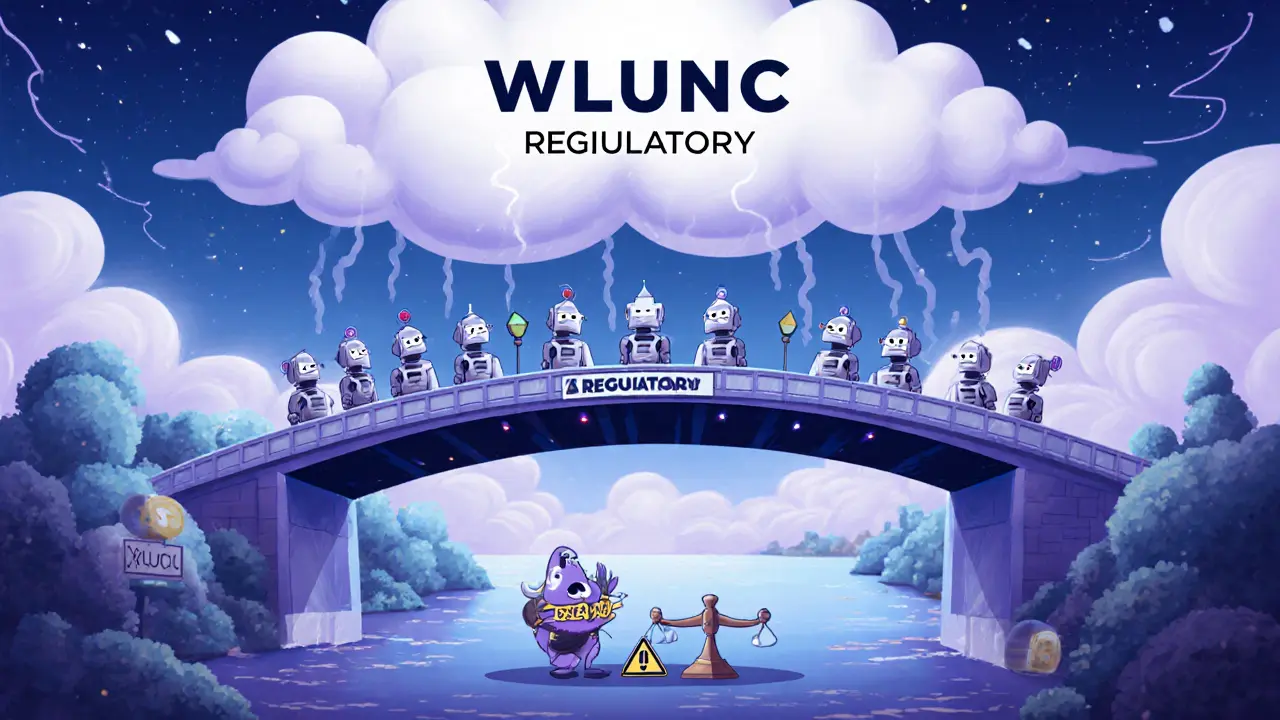WLUNC Bridge Fee Calculator
Calculate Your WLUNC Bridge Costs
Estimate the total fees for converting LUNC to WLUNC including bridge fees and Ethereum gas costs.
Estimated Bridge Cost Breakdown
Bridge Fee:
Ethereum Gas Fee:
Total Estimated Cost:
Bridge fee: 0.3% of LUNC amount
Gas estimate: ~0.0005 - 0.0015 ETH per transaction
Gas price: Gwei
Important Notes
- Bridge fees are fixed at 0.3% of the LUNC amount.
- Ethereum gas fees vary based on network congestion and gas price.
- Actual costs may differ due to fluctuating gas prices and network conditions.
Wrapped LUNA Classic (WLUNC) is a ERC-20 token on Ethereum that mirrors Terra Luna Classic (LUNC) at a 1:1 ratio. After the May2022 Terra hard fork, the community needed a way to move LUNC into the massive Ethereum DeFi ecosystem, and WLUNC became that bridge.
How does WLUNC actually work?
The token lives on Ethereum blockchain, so it follows the ERC-20 standard. When you “wrap” LUNC, a smart contract locks the equivalent amount of native LUNC on the Terra Classic chain and mints the same number of WLUNC on Ethereum. The peg is maintained by arbitrage: if WLUNC trades above LUNC, traders can swap the cheap LUNC for the expensive WLUNC, sell the WLUNC on Ethereum, and profit, pushing the price back down.
Cross‑chain transfers rely on a set of 12 validator nodes that must reach a 9‑of‑12 consensus before the mint or burn operation finalises. This multi‑signature approach is managed by a decentralized autonomous organization (DAO) that can pause the bridge in emergencies and upgrade the contract when needed.
Why would anyone hold WLUNC instead of native LUNC?
The biggest draw is access to Ethereum’s $53billion DeFi landscape. You can supply WLUNC to protocols like Aave and earn a few percent APY, or provide liquidity on Uniswap and collect trading fees. In Q22025, WLUNC/LUNC pools on Uniswap generated about $1.7million in fees each month.
Because WLUNC lives on Ethereum, you also benefit from the network’s security model and can use any Ethereum‑compatible wallet-MetaMask, Trust Wallet, hardware wallets, you name it. Native LUNC, by contrast, is stuck on the Terra Classic chain, which has limited DeFi integrations and a dwindling user base.

What are the downsides?
- Bridge fees: each conversion costs about 0.3% plus the typical Ethereum gas fee (roughly 0.0005‑0.0015ETH per transaction in Q22025).
- Liquidity gaps: only 37 centralized exchanges list WLUNC versus over 140 for native LUNC, leading to higher slippage on larger trades.
- Price drift: the 0.6% average discrepancy between WLUNC and LUNC means the peg isn’t perfectly stable.
- Regulatory risk: a March2025 SEC guidance hinted that some wrapped tokens could be deemed securities; WLUNC falls into a gray area.
How to get WLUNC - a step‑by‑step guide
- Set up an Ethereum‑compatible wallet (MetaMask is the most common).
- Purchase or transfer some ETH to cover gas fees.
- Visit a supported bridge portal (for example, the official Terra Classic bridge site).
- Connect your wallet, specify the amount of LUNC you want to wrap, and confirm the transaction.
- The bridge will lock LUNC on Terra Classic and mint the same amount of WLUNC in your Ethereum wallet.
- Now you can move WLUNC to DeFi protocols, swap it on Uniswap, or hold it in your wallet.
The whole process usually takes 25‑45minutes, but heavy network congestion can push it to several hours-one Reddit user reported a 17‑hour wait for a $1,200 wrap in June2025.
Comparing WLUNC with similar wrapped assets
For a quick reference, compare WLUNC with its native counterpart and with another popular wrapped asset, Wrapped Bitcoin (WBTC):
| Feature | WLUNC | LUNC (native) | WBTC |
|---|---|---|---|
| Blockchain | Ethereum | Terra Classic | Ethereum |
| Standard | ERC‑20 | Native token | ERC‑20 |
| Governance | DAO‑controlled bridge (12 validators) | Terra Classic DAO | Centralized custodian model (17 institutions) |
| Typical DeFi APY (2025) | ~4.2% on Aave | ~1% on Terra Classic farms | ~5‑7% on various platforms |
| Bridge fee | 0.3% | N/A | ~0.15% |
| Exchange coverage | 37 exchanges | 142 exchanges | Over 200 exchanges |

Common questions about WLUNC
Frequently Asked Questions
Is WLUNC the same as LUNC?
No. WLUNC is an ERC‑20 representation of LUNC on Ethereum. The peg is 1:1, but the two tokens live on different blockchains and have distinct transaction costs and DeFi opportunities.
How safe is the WLUNC bridge?
The bridge uses a multi‑signature DAO with 12 validators and an emergency pause function. A January2025 audit flagged three medium‑risk oracle issues, but no critical vulnerabilities have been exploited to date.
Can I earn yield with WLUNC?
Yes. Platforms like Aave, SushiSwap, and Lido accept WLUNC for lending, staking, or liquidity provision, with reported APYs ranging from 3% to 15% depending on the protocol and market conditions.
What fees should I expect?
You’ll pay a 0.3% bridge fee plus Ethereum gas (about $3.50‑$12.75 in Q22025). Some exchanges also charge a small trading fee when you swap WLUNC for other assets.
Is WLUNC regulated?
Regulators have not explicitly classified WLUNC, but a 2025 SEC guidance suggests wrapped tokens could fall under securities law. Keep an eye on future rulings if you plan a large investment.
Bottom line
If you already own LUNC and want to tap into Ethereum’s DeFi world, WLUNC offers a practical bridge-provided you’re comfortable with bridge fees, occasional liquidity crunches, and the regulatory uncertainty that still hangs over many wrapped assets.
Annie McCullough
June 4, 2025 AT 14:08So WLUNC is basically LUNC wrapped for Ethereum, but the whole bridge fee model feels like a relic from 2017 🚀 you know the whole 0.3% fee plus unpredictable gas, it’s just a recipe for user confusion :)
Scott Hall
June 6, 2025 AT 04:59Hey folks, wrapping LUNC can be a neat way to hop onto DeFi opportunities on ETH, just keep an eye on gas spikes and don’t over‑commit your holdings. Stay chill and happy swapping!
Jade Hibbert
June 7, 2025 AT 19:51oh wow, another fee calculator, because we needed more math in our lives lol. i guess if you’re okay with paying a few cents in gas, go ahead. typos r real tho.
Leynda Jeane Erwin
June 9, 2025 AT 10:42Dear reader, the mechanism herein described utilizes a cross‑chain bridge-an engineering marvel, in theory.
But let’s be real, you’ll still need to monitor the gas market like a hawk. No biggie, just do it.
Brandon Salemi
June 11, 2025 AT 01:33Quick tip: if you’re moving a small amount of LUNC, the bridge fee alone can eat up most of your profit. Check the numbers before you act.
Mureil Stueber
June 12, 2025 AT 16:25Just a heads‑up: wrapping LUNC exposes you to Ethereum’s volatility and potential smart‑contract risks. The bridge has been audited, but no system is foolproof.
Leo McCloskey
June 14, 2025 AT 07:16Honestly, this whole bridging craze feels like a Band-Aid over a broken infrastructure problem; we’re just moving risk around instead of solving anything.
arnab nath
June 15, 2025 AT 22:08What they don’t tell you is that the bridge operators could be a front for a coordinated market manipulation scheme. Keep your keys safe.
Jacob Moore
June 17, 2025 AT 12:59Don’t let the fees scare you off-if you’re in it for the long game, WLUNC can give you access to liquidity pools you’d otherwise miss.
Manas Patil
June 19, 2025 AT 03:51From a cross‑chain perspective, the WLUNC bridge is a stepping stone toward a more interoperable DeFi ecosystem. Just watch the gas market.
Carol Fisher
June 20, 2025 AT 18:42🇺🇸 If you’re an American investor, remember the IRS treats wrapped tokens as taxable events. 📊 Stay compliant!
Melanie Birt
June 22, 2025 AT 09:34Right on, the tax implications are real. Also, make sure you use a reputable bridge UI and double‑check the contract address before confirming.
gayle Smith
June 24, 2025 AT 00:25Wow, the drama of a 0.3% fee! It’s like watching a soap opera where the villain is gas and the hero is a tiny fraction of LUNC. Hold onto your popcorn.
mark noopa
June 25, 2025 AT 15:17When we contemplate the ontological implications of wrapping a token, we must first ask: what is the essence of value when it traverses a synthetic conduit? The act of encapsulation-transforming LUNC into WLUNC-mirrors the ancient alchemical pursuit of transmutation, albeit in a digital crucible. Yet, this transmuted state is not without its epistemic burdens. The bridge fee, a modest 0.3%, ostensibly serves as a mere transactional tax, but it also represents an extraction of agency from the user, a subtle reminder of the centralized guardianship that underpins even the most decentralized architectures.
Consider also the ethereal nature of Ethereum’s gas. While one might dismiss it as a peripheral inconvenience, gas is the lifeblood of execution, dictating the velocity and cost of every metamorphosis. In periods of network congestion, gas prices can erupt like a volcanic eruption, rendering the cost of wrapping prohibitive and eroding any marginal gains. This volatility is not just an economic variable; it is a sociotechnical feedback loop that influences user behavior, market dynamics, and ultimately the perceived legitimacy of the bridge itself.
Moreover, the very act of bridging introduces a vector of systemic risk. Smart‑contract vulnerabilities, governance disputes, and the ever‑present specter of a 51% attack on the underlying chains create a tapestry of interdependent failure modes. One might argue that diversification across chains mitigates risk, yet it also diffuses accountability. Who, then, bears responsibility when a bridge hack siphons off assets? The answer, in practice, is a murky consortium of developers, auditors, and users, each clutching at the frayed edges of trust.
In sum, WLUNC is a fascinating case study in the convergence of finance, technology, and philosophy. It challenges us to reevaluate the boundaries of ownership, the cost of interoperability, and the ethical dimensions of custodial infrastructure. As participants in this evolving ecosystem, we must navigate these waters with both curiosity and caution.
Hanna Regehr
June 27, 2025 AT 06:08That was a deep dive-thanks for laying it out. Bottom line: do your homework, watch gas, and only wrap what you’re comfortable potentially losing.
Ben Parker
June 28, 2025 AT 20:59Cool 😎
Daron Stenvold
June 30, 2025 AT 11:51Indeed, the brevity of that sentiment belies the complexity of the bridge mechanics. Proceed with measured optimism.
Lena Vega
July 2, 2025 AT 02:42I appreciate the concise overview; it’s helpful.
Emily Kondrk
July 3, 2025 AT 17:34All this talk about fees is just a distraction from the fact that the whole DeFi narrative is a controlled experiment. They want us to think we have agency while the bridge is a backdoor for data harvesting. Stay woke!
Laura Myers
July 5, 2025 AT 08:25OMG, the drama of bridging is like a reality TV show! One minute you’re celebrating low fees, the next you’re crying over gas spikes. What a rollercoaster.
Anjali Govind
July 6, 2025 AT 23:17I’m curious how WLUNC will integrate with upcoming cross‑chain liquidity aggregators. It could open new arbitrage paths if the fees stay low.
Sanjay Lago
July 8, 2025 AT 14:08Totally agree! As soon as the aggregators roll out, we’ll see some real action. Let’s keep an eye on the updates and share any tips.